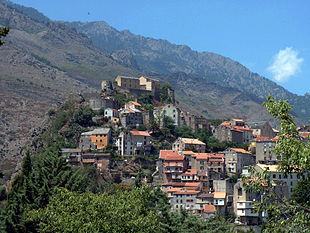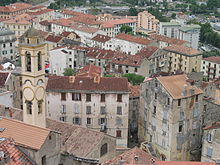Corte
| Corte | ||
|---|---|---|

|
|
|
| region | Corsica | |
| Department | Upper Corsica | |
| Arrondissement | Corte | |
| Canton | Corte (main town) | |
| Community association | Center Corse | |
| Coordinates | 42 ° 18 ' N , 9 ° 9' E | |
| height | 299-2,626 m | |
| surface | 149.27 km 2 | |
| Residents | 7,446 (January 1, 2017) | |
| Population density | 50 inhabitants / km 2 | |
| Post Code | 20250 | |
| INSEE code | 2B096 | |
Corte ( Corsican Corti ) is a municipality and the only significant city and sub-prefecture of the arrondissement of the same name in the interior of the French island of Corsica at the confluence of Restonica and Tavignano . It is located on a high plateau at an altitude of 436 m and has 7446 inhabitants (as of January 1, 2017). Through the Corsican statesman Pascal Paoli , Corte was the island's capital from 1755 to 1769 .
The battles of the Middle Ages and the wars for independence have left their mark on the town. Today Corte, with its picturesque old town, is a tourist highlight on the island and has retained its original character, especially in the upper part, with its narrow, steep streets between the slate-roofed houses.
history
With its gorges and mountains, Corte has always played an important military role. It was an important city in the 9th century and was conquered by the Republic of Genoa in the 13th century. In 1419 the feudal lord Vincentello d'Istria conquered the place and built the citadel . Later, the Bank of St. George (the Genoese military financial institution ) received the city from the feudal lords of Campo Fregosso .
During the brief French affiliation in 1553, the Marshal of Thermes sent the noble Sampiero Corso to the city; he became their liberator; the residents voluntarily gave him the keys. After the signing of the Peace Treaty of Cateau-Cambresis in 1559, Corsica fell back to Genoa.
In 1734, however, the French took control of the city again. But in 1745 the Corsicans conquered the city again under Jean-Pierre Gaffori ("Protector of the Nation"). In 1751 the “Consulta von Orezza” entrusted him with executive power.
Between 1755 and 1769, Corte was the capital of the independent part of Corsica under Pascal Paoli . This "open-minded despot", friend of Jean-Jacques Rousseau and James Boswell , reorganized Corsica as a state and gave it a democratic constitution . The separation of powers and popular sovereignty were already anchored in it. At the same time he founded the first (and to date only) Corsica university in the National Palace. However, Genoa retained supremacy on the coast.
Since Paoli refused to negotiate with Genoa, that republic turned to France. Under Choiseul , a minister of Louis XV. , the island was "sold" to France in the Treaty of Versailles (1768) . This "sale" caused Paoli and his compatriots to start a new uprising. After the defeat in the Battle of Ponte Novu in May 1769, Paoli withdrew to Corte, but after unsuccessful resistance, the city fell back into the hands of the French.
Population development
| year | 1962 | 1968 | 1975 | 1982 | 1990 | 1999 | 2007 | 2016 |
| Residents | 5066 | 4948 | 5230 | 5177 | 5693 | 6329 | 7280 | 7389 |
| Sources: Cassini and INSEE | ||||||||
The citadel
The Citadel of Corte is the only major military fortress inland. The ledge was fortified as early as the 9th century. However, it was not until 1419 that the castle was built under the Corsican adventurer Vincentello d'Istria , viceroy of Aragon . The “eagle's nest”, the southern tip of the rock spur, is particularly impressive. It can be reached via a staircase made of "Restonica marble". Originally there were small houses and a chapel inside the citadel. Louis XV and finally Louis XVI. changed this part and started building the barracks .
But it was only under Louis Philippe that the fortress got its final appearance. The houses and the chapel were destroyed and the residents were housed in the "Lubiacce", the "building of 100 residents". The military buildings initially housed the garrison and were then converted into a prison for political prisoners.
During the First World War , German prisoners of war were housed there; during the Second World War , Corsican patriots were held captive under the Italian occupation .
From 1962, after the end of the Algerian War , the Foreign Legion was stationed there. Since the legionaries' withdrawal in 1983, the area has belonged to the city of Corte.
The facilities can be visited: From the “eagle's nest” one has a wonderful view of the surroundings. Today the citadel houses the national park office, a museum on Corsican history and facilities of the university.
Infrastructure
The city is home to the only university in Corsica, re-established in 1980 , the Pascal Paoli University of Corsica , and the Citadel houses the Corsican Ethnographic Museum .
Corte has good transport links to the island's ports via national roads (N 193 Bastia - Ajaccio and N 200 to Aléria ) and the Corsican railway .
economy
In the municipality, controlled designations of origin ( AOC ) apply for
- Brocciu cheese,
- Honey (French Miel de Corse , Corsican Mele di Corsica )
- Olive oil (French Huile d'olive de Corse , Corsican Oliu di Corsica )
- Chestnut flour (French Farine de châtaigne corse , Corsican Farina castagnina corsa )
and Protected Geographical Indications ( IGP ) for wine (Ile de Beauté and Méditerranée, each blanc, rosé or rouge ).
Personalities
- Joseph Bonaparte (1768–1844), the eldest brother of Napoleon Bonaparte
- Sauveur Casanova (1918–1998), Roman Catholic Bishop of Ajaccio
- Dominique Colonna (* 1928), former soccer player, now runs a hotel in the Restonicatal
Web links
- Official tourism website of the Corte region
- French-language homepage of the University of Corte
- Faculty of Sciences of Corté
Individual evidence
- ↑ La ville de Corte. In: Annuaire-Mairie.fr. Retrieved July 17, 2012 (French).





